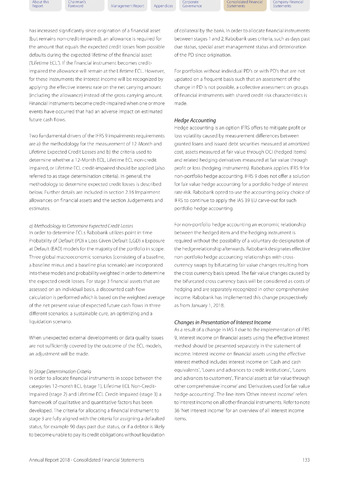About this
Report
Chairman's
Foreword
Corporate
Management Report Appendices Governance
Consolidated Financial Company Financial
Statements Statements
has increased significantly since origination of a financial asset
(but remains non-credit-impaired), an allowance is required for
the amount that equals the expected credit losses from possible
defaults during the expected lifetime of the financial asset
('Lifetime ECL'). If the financial instrument becomes credit-
impaired the allowance will remain atthe Lifetime ECL. However,
for these instruments the interest income will be recognized by
applying the effective interest rate on the net carrying amount
(including the allowance) instead of the gross carrying amount.
Financial instruments become credit-impaired when one or more
events have occurred that had an adverse impact on estimated
future cash flows.
Two fundamental drivers of the IFRS 9 impairments requirements
are a) the methodology for the measurement of 12-Month and
Lifetime Expected Credit Losses and b) the criteria used to
determine whether a 12-Month ECL, Lifetime ECL non-credit
impaired, or Lifetime ECL credit-impaired should be applied (also
referred to as stage determination criteria). In general, the
methodology to determine expected credit losses is described
below. Further details are included in section 2.16 Impairment
allowances on financial assets and the section Judgements and
estimates.
a) Methodology to Determine Expected Credit Losses
In order to determine ECLs Rabobank utilizes point in time
Probability of Default (PD) x Loss Given Default (LGD) x Exposure
at Default (EAD) models for the majority of the portfolio in scope.
Three global macroeconomic scenarios (consisting of a baseline,
a baseline minus and a baseline plus scenario) are incorporated
into these models and probability weighted in order to determine
the expected credit losses. For stage 3 financial assets that are
assessed on an individual basis, a discounted cash flow
calculation is performed which is based on the weighted average
of the net present value of expected future cash flows in three
different scenarios: a sustainable cure, an optimizing and a
liquidation scenario.
When unexpected external developments or data quality issues
are not sufficiently covered by the outcome of the ECL models,
an adjustment will be made.
b) Stage Determination Criteria
In order to allocate financial instruments in scope between the
categories 12-month ECL (stage 1), Lifetime ECL Non-Credit-
Impaired (stage 2) and Lifetime ECL Credit-Impaired (stage 3) a
framework of qualitative and quantitative factors has been
developed. The criteria for allocating a financial instrument to
stage 3 are fully aligned with the criteria for assigning a defaulted
status, for example 90 days past due status, or if a debtor is likely
to become unable to pay its credit obligations without liquidation
of collateral by the bank. In orderto allocate financial instruments
between stages 1 and 2, Rabobank uses criteria, such as days past
due status, special asset management status and deterioration
of the PD since origination.
For portfolios without individual PD's or with PD's that are not
updated on a frequent basis such that an assessment of the
change in PD is not possible, a collective assessment on groups
of financial instruments with shared credit risk characteristics is
made.
Hedge Accounting
Hedge accounting is an option IFRS offers to mitigate profit or
loss volatility caused by measurement differences between
granted loans and issued debt securities measured at amortized
cost, assets measured at fair value through OCI (hedged items)
and related hedging derivatives measured at fair value through
profit or loss (hedging instruments). Rabobank applies IFRS 9 for
non-portfolio hedge accounting. IFRS 9 does not offer a solution
for fair value hedge accounting for a portfolio hedge of interest
rate risk. Rabobank opted to use the accounting policy choice of
IFRS to continue to apply the IAS 39 EU carve-out for such
portfolio hedge accounting.
For non-portfolio hedge accounting an economic relationship
between the hedged item and the hedging instrument is
required without the possibility of a voluntary de-designation of
the hedge relationship afterwards. Rabobank designates effective
non-portfolio hedge accounting relationships with cross-
currency swaps by bifurcating fair value changes resulting from
the cross currency basis spread. The fair value changes caused by
the bifurcated cross currency basis will be considered as costs of
hedging and are separately recognized in other comprehensive
income. Rabobank has implemented this change prospectively
as from January 12018.
Changes in Presentation of Interest Income
Asa result ofa change in IAS 1 due to the implementation of IFRS
9, interest income on financial assets using the effective interest
method should be presented separately in the statement of
income. Interest income on financial assets using the effective
interest method includes interest income on 'Cash and cash
equivalents', 'Loans and advances to credit institutions', 'Loans
and advances to customers','Financial assets at fair value through
other comprehensive income' and 'Derivatives used for fair value
hedge-accounting'. The line-item 'Other interest income' refers
to interest income on all other financial instruments. Refer to note
36 'Net interest income' for an overview of all interest income
items.
Annual Report 2018 - Consolidated Financial Statements
133

